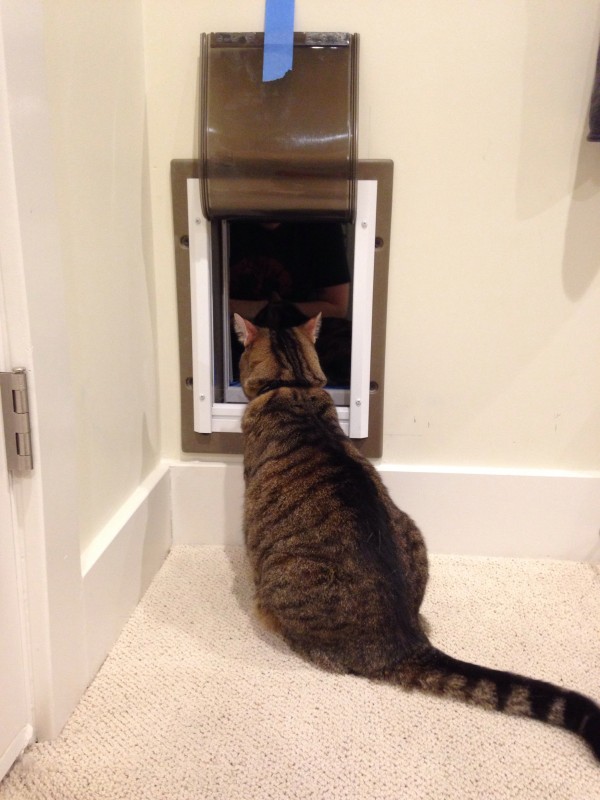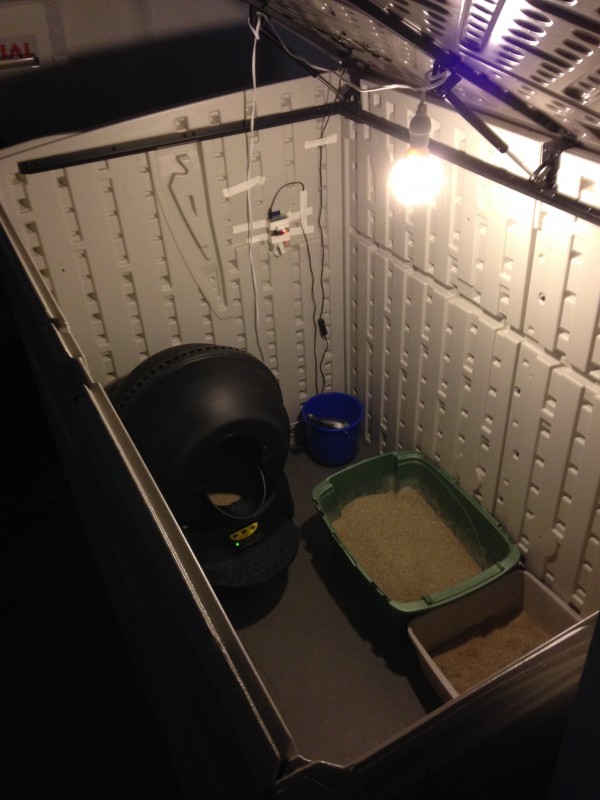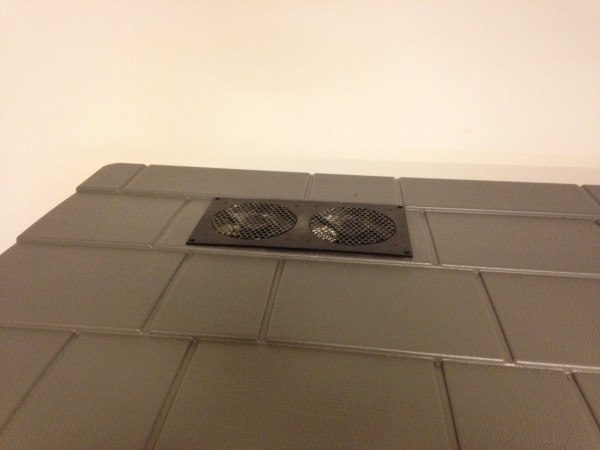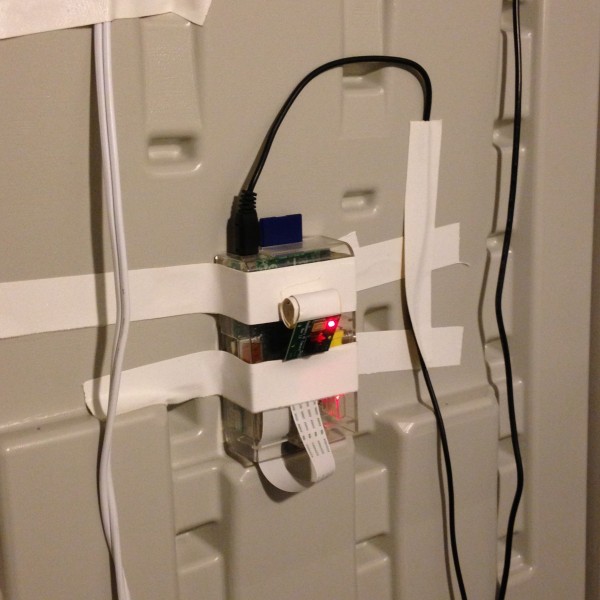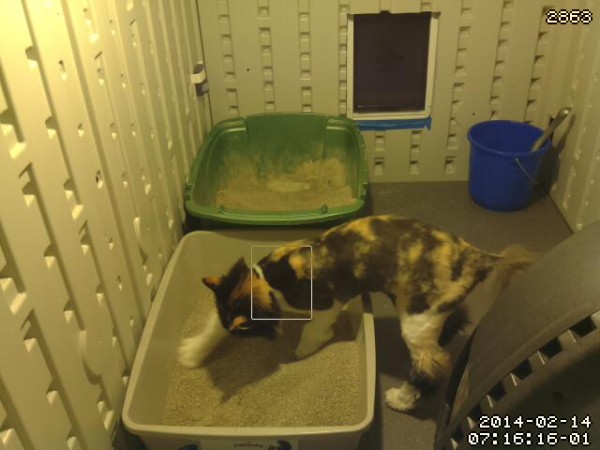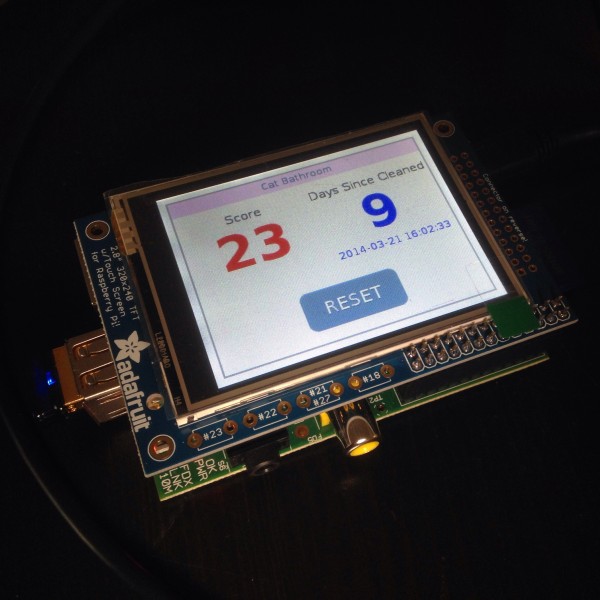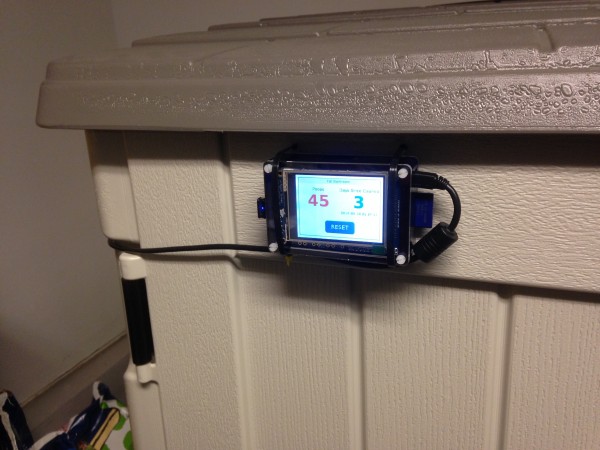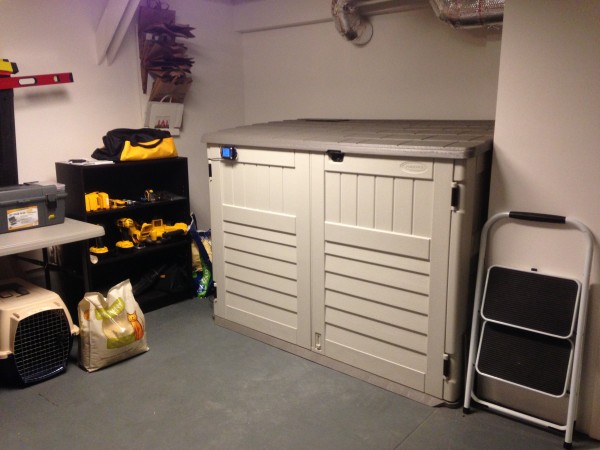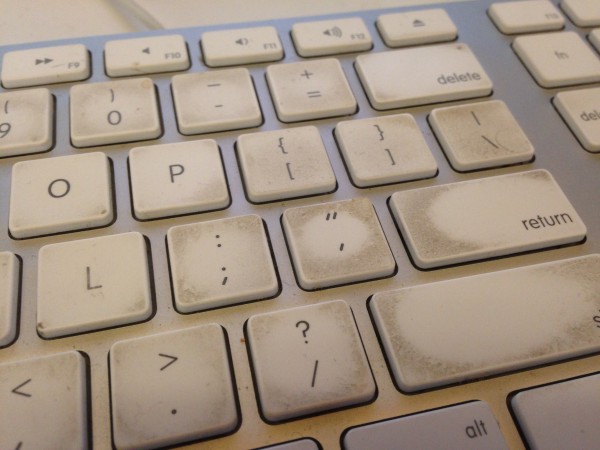Building a Better Cat Bathroom
Filed Under Gadgets & Hardware, Geek, Lifehacks | 2014-04-21, 14:19
I’ve had cats for many years. This means I’ve had to deal with litter boxes for just as long. When you have one cat, it’s not a big deal. However when you have three of them, like we do, the litter box challenges are greater. For years I dreamed about solving all of these challenges with the perfect litter box situation. We haven’t quite achieved that level of greatness, but what we’ve put together is pretty damn close.
With 3 cats we’ve had 2-3 litter boxes. They’ve been placed in laundry rooms, bathrooms, kitchens, closets, showers, tubs, and just about anywhere in an attempt to make them work. Up until now we rented, so we never wanted to invest the time or money into a more permanent solution. Plus none of our rental apartments had the space for it! When we finally bought a house last year, we resolved to finally solve this problem: Introducing the Cat Bathroom.
The Cat Bathroom was originally designed as an additional room with framing and doors and whatnot, but then we found a garden shed that was the perfect size. It comfortably holds 3 litter boxes and gives the cats plenty of room to walk around and do their business. In a single afternoon we assembled the shed, cut a hole in the side with a jigsaw, and then cut a hole in the wall between our downstairs room and the garage so that we could install the cat door. The cats love it, and we’ve had almost no “registering of complaints” in other areas of the house.
Inside the Cat Bathroom we have three litter boxes. One of the litter boxes is a Litter Robot, which cleans itself. I highly recommend these if your cat will use it. Some of our cats aren’t as fond of it, so we’ve still got two normal boxes. In order to get into the Cat Bathroom, the cats have to climb through the pet door. Since it’s not level with the ground, the cats don’t track the loose litter out into our living space. No longer do we have to step on litter when using a “shared” bathroom barefoot. The shed also has two large doors that swing open and a hydraulically assisted lid that allows for super easy cleaning of the boxes. Because it’s already in the garage it means we never have dirty litter sitting in the house waiting to be taken out.
We learned a very important lesson after the first few days of the Cat Bathroom: ventilation is important. The smell of opening the lid after the first few days was overpowering. A simple exhaust fan found on Amazon and some more jig saw cutting and that problem was easily solved. It exhausts into the garage, which has enough air flow that the smell is never noticed. Gone are the days of nice dinners ruined by the smell emanating from the corner of the kitchen.
Most people would probably stop with that setup and call it good. However I’m not “most people” and wanted to make it a little bit fancier. I’ve already implemented a large amount of home automation with Insteon/X10 hardware and Indigo software. Since I already had that all setup, and I had a leftover X10 motion sensor, I decided to use it — in conjunction with Splunk — to track how often the cats used the litter box. It was an excellent way to make sure full adoption of the Cat Bathroom was happening at the beginning.
The X10 motion sensor sits right inside the door, so the cats trigger it whenever they walk in. It sends a signal to an X10 receiver, which is then picked up by the Indigo software. The Indigo software logs the trip, increments a variable counting the number of trips, and then calls a custom python script that posts a randomly selected message to the Twitter account setup for the @CatBathroom. The Twitter account has 13 followers. I’m still not sure why.
"Why are you following @catbathroom?" – @edrabbit
"YOU'RE the one who made a account about your cat's litterbox. WE aren't the weird ones."
— KC (@KdotCdot) January 29, 2014
As part of “making sure the cats are using it” I wanted a way to know which cat was using it so we were sure all 3 of them were on board. I happened to have a Raspberry Pi and a camera module sitting on my desk. A little bit of work later and I had motion triggered video recording setup with it. As you can see, I’ve opted for the super high-tech “wad of tape” method of mounting and aiming the camera. I also found out that the Raspberry Pi camera wasn’t so hot at low-light, so I hung an LED bulb in there that’s always one. I like to think that in addition to making the camera work, it also makes the Cat Bathroom friendlier than the dark cave it used to be.
Now we have security camera style footage of the cats using the bathroom. Yes, it’s weird to watch it. If anyone needs almost 2gb of cats and litter boxes for a bizarre art project, get in touch with me. I will admit, there’s a bit of a temptation to hook up automated photo uploading to the Twitter account. Be warned.
The Cat Bathroom solved many of our problems, but it turned out that it caused one rather big one. Since the litter boxes were hidden away from sight, we had a tendency to forget about them. This meant it would be several days before we realized “oh yeah, we need to clean the litter boxes”. Needless to say the cats were a little unhappy about it. Enter an over-engineered solution…
Another Raspberry Pi plus a small LCD touchscreen for display was the hardware of choice. I threw together a super simple flask based webserver that would query the Indigo API for the number of trips the cats had made to the bathroom and also calculate how many days it had been since the last cleaning. If either number gets to high, it turns red to draw attention to our lack of diligence. And there’s a button to tap when I clean the litter box, which resets the counters (and of course sends a tweet). I noticed it occasionally crashing and not reloading the page, so I tossed it on a WeMo switch so I can reset it easily.
You can check out the code I’m using over on github. I’m hoping to turn it into a more full-fledged house server with more than just the Cat Bathroom status at some point.
Another smaller problem I ran into was that the cats had learned to jump directly into the Litter Robot, bypassing the step that triggers the countdown to cleaning. This meant the Litter Robot wasn’t cycling and cleaning itself after every use. Sure I could just go in there and manually switch it off and back on again in true “IT Crowd” fashion to force a cleaning, but that’s too easy. I had a WeMo switch left over from our Christmas tree lights, so I plugged the Litter Robot into it. Now I can clean one of the litter boxes from my phone.
So what’s next for the Cat Bathroom? RFID collars and litter box weight analysis are just some of the suggestions I’ve heard. But I wouldn’t want to get too carried away with this…
Cost breakdown
Suncast 3′ x 8′ x 5.11′ Storage Shed – $350
Pet Door – $88
Cabinet fan for exhaust – $35
Raspberry Pis, camera, LCD, motion sensor, WeMos, etc – [REDACTED]
Not stepping in cat litter when getting out of the shower: Worth every single penny.
More Pictures in the Flickr Set
How To Clean an Apple Aluminum Keyboard
Filed Under Apple, Geek, Lifehacks | 2013-11-07, 17:30
My Apple keyboard gets awfully dirty over the years, but is built well enough to not need replacing. That means I end up with a grimy but functional keyboard. I decided it was finally time to clean my work keyboard since I hadn’t in almost 4 years. How to clean it though? Quite simply, get some baby wipes and scrub each key individually. Here’s the before and after:
NeverWet means superhydrophobic cardboard
Filed Under Gadgets & Hardware, Geek, Hacks and Mods, Lifehacks, Video | 2013-07-05, 14:50
This cardboard hates water. This was my first test run with NeverWet to see how well it works. NeverWet is a superhydrophobic coating that can be applied to just about anything. It comes in a pair of spray cans and takes a few hours to fully dry. Then whatever you treated will never get wet. It literally repels the water. What should I do next?
Here’s a video from the makers with some more examples:
Lifeloggers Documentary
Filed Under Gadgets & Hardware, Geek, Lifehacks, Self Tracking, Video | 2013-06-06, 00:23

Memoto presents a short (23 minute) documentary on Lifeloggers. It’s a great conversation with a number of the characters in the Quantified Self, Lifelogging, Self-Tracking, “Record All The Things!” movement. I couldn’t help but smile when I saw Dave Asprey wearing a Splunk shirt. (Disclaimer: I work for Splunk and am using Splunk Storm to track my own self.) There’s also some good blog posts over on Memoto’s site including an interview with Steve Mann.
How much ice does it take to fill a bath tub?
Filed Under Art, Lifehacks, Personal, Pranks | 2013-06-02, 21:23
We’re moving in a few weeks to a new house in San Francisco. Of course this means we had to throw a housecooling party at our current place before we could have a housewarming at the new place. I know, I know Party Laws are strict but you have to follow the rules. Over dinner with friends @aerialdomo put forth the idea of filling a bathtub with pudding came up. Unfortunately that idea was rejected immediately. After Jell-O and H2Goo were both shot down as well, we decided to compromise on ice. Fun and functional!
The day of the party, I realized I had no idea how much ice we would actually need. I jumped online of course, consulting the internet brain and couldn’t find a definitive answer.
Our tub is 24″ wide, 60″ long, and 16″ deep, or about 13 cubic feet. Back of the envelope calculations by multiple people resulted in estimates ranging from 40lbs to 500lbs as we couldn’t get a definitive answer on the volume of a bag of ice cubes. What were we to do? The answer was of course, just keep adding ice until it’s full. The result:

In the end, 185lbs of bagged ice cubes filled most of the tub. This was of course with some of the space taken up by bottles of beer, soda, and champagne. I estimate 200lbs would have given us a nice full tub. So there you go, to fill a basically standard tub, you probably need about 200lbs of ice. Or if you have a different sized tub, each pound of ice cubes will take up 0.065 cubic feet. I couldn’t find this info on the internet before, but now you can. And no, we didn’t steal anyone’s kidneys.
Lego Salt and Pepper Shakers
Filed Under Art, Gadgets & Hardware, Lifehacks | 2007-07-20, 17:25

Finally, mom will let me bring my Legos to the dinner table! In a neat use of a childhood toy near and dear to my heart, designer Joel Hesselgren has put together a simple yet ingenous salt and pepper shaker made out of legos. Rather than create separate shakers, he combines them into one. By moving the top lego piece you can control the amount of each flavor enhancer.


Source: Yanko design via

How to Tie Your Shoes in a Different Way
Filed Under Education, Lifehacks, Websites | 2007-07-07, 16:13

Bored of the tried and true method of lacing and tying your shoes? Ian’s got the cure for that boredom at his shoelace site. He has tons of new and interesting ways to lace and tie your shoes.
Technology-induced synaesthesia
Filed Under Body Modification, Lifehacks, Tools | 2007-06-24, 23:58

“See with your tongue. Navigate with your skin. Fly by the seat of your pants (literally). How researchers can tap the plasticity of the brain to hack our 5 senses — and build a few new ones.”
A great article over at Wired that speaks for itself. Anyone interested in body hacking shoudl definitely check it out.
Mixed Feelings (via BoingBoing
Know who is talking about you on the Internet
Filed Under Lifehacks, Tools | 2007-06-24, 23:55

Lifehacker has a great little how-to on using MonitorThis to keep tabs on certain subjects on the internet. Most people will use it for the obvious ego searching, but it’s also handy for keeping on top of news on other subjects you’re interested in. Learn how with Feed your ego with RSS.
How to Improve Your Night Vision
Filed Under Lifehacks, Video | 2007-06-24, 23:53
For many of us, the dark of the night is our friend, but how do you keep from barking your shins on the coffee table again? Ninja’s never seem to have these problems. Instructable’s user Sam Noyoun posted 10 tips on how to improve your night vision, including the old pirate eye-patch trick. This is one for those of us that can’t afford night vision goggles.
Improve Your Night Vision – video powered by Metacafe
via instructables
